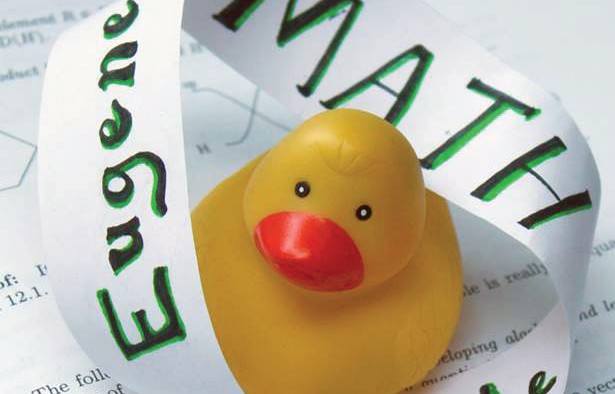 Natural Sciences
Natural Sciences
The Importance of Getting It Wrong

Other than lunch and snack time, math is eight-year-old Zara’s favorite part of the school day.
Zara doesn’t just like math. She practically vibrates when she knows an answer, stretching so hard to be called on that she probably grows another half-inch during every class.
The place Zara loves doing math the most is the Eugene Math Circle, a weekly class offered through the UO Department of Mathematics for kids seeking more of a challenge than their regular schools provide. The math circle is a place where kids eager to learn more about numbers—and there are more of these kinds of kids than you might think—can geek out on binaries, powers, formulas and fractions.
“I just think it’s really fun figuring out things, because I like solving puzzles and stuff,” Zara said, after solving a set of problems involving binary numbers. “It’s funner because it challenges me, and I like to be challenged.”
That’s mathematical music to the ears of Maria Nemirovskaya, an instructor in the math department and organizer of the Eugene Math Circle. Several other UO faculty members take part, offering five afterschool classes on the UO campus for elementary, middle and high school students.
It’s something of a labor of love for Nemirovskaya, who says there’s nothing like the look on the face of a child who suddenly understands not just the answer to a problem, but the mental steps to get there.
“With kids, unlike with adults, you can see it when it clicks,” she said. “There is a light in their eyes, they’re jumping up—and my kids literally jump—and their faces change when they get this ‘a-ha!’ You can see the transformation.”
Nemirovskaya, who teaches two elementary-level courses, lights up in much the same way when she talks about her students and what they’re learning. And what they’re learning isn’t strictly math—it’s more like training for young brains.
“In my elementary classes, of course I teach math,” Nemirovskaya said. “But the most important part that I teach is how to think, to think outside the box, to just use your brain. (Typical) elementary school math is problems with recipes. I give them problems without recipes.”
Nemirovskaya’s first goal is to guide her students toward identifying the crux of a math problem. Two recent questions she posed to them:
- A chicken standing on two legs weighs eight pounds. How much does that chicken weigh if it stands on one leg?
- Three workers paint three rooms in three hours. How long does it take six workers to paint six rooms? (Want the answers?)
It’s not all about getting the right answer. Math circle teachers also emphasize the importance of getting it wrong.
Being wrong is actually an important part of learning math, because even the smartest people are often wrong and being wrong is a necessary step in problem-solving, especially as problems get more complicated.
In fact, Nemirovskaya starts every class with a problem that’s designed to elicit a wrong answer on the first try. The learning happens as students figure out why.
“I try to make sure they’re not afraid to get the wrong answers, and that getting the wrong answer is actually a very positive outcome,” she said. “I’m trying to teach them analytical skills and develop their brains. From my standpoint, that’s even more important than the math.”
—Greg Bolt


 Twitter
Twitter Facebook
Facebook Forward
Forward